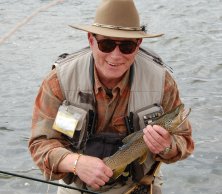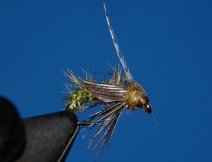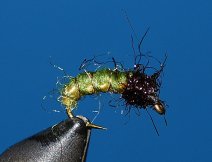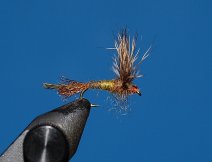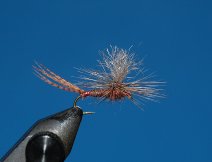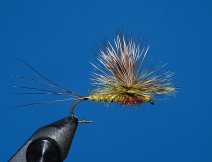Is there a possibility of truly capturing the essence of nature on canvas or a metal hook?
Is there a possibility of truly capturing the essence of nature on canvas or a metal hook? My fly tying started many years ago. Through the years of talking to and watching other tiers, there was still an emptiness inside of me for more knowledge to create better flies. I decided to learn more on the biology of trout, pacifically the vision of trout and how they view objects in their under water world. A trouts vision is based on the refraction of light. There was a few books published through the years that discussed the use of a slant tank, this tank allows us to see the under water world as trout see it. My son Michael and I constructed a slant tank and through the use of this tank a wealth of knowledge was gained. A slant tank is the perfect scenario of the underwater world but even in this scenario trout will view flies as different illusions. The illusions of a fly are created from the refraction of light. If these illusions occur in this perfect scenario, what truly happens in our rivers and streams that are controlled by nature. Viewing artificial flies and live flies thru a slant tank proves to a fly tier that sparkles of light and color are two factors that must be used in fly tying. With visions of illusions, one must only have to create an impression of life.
I obtained a book for my library titled, "Sunshine and the Dry Fly" by J. W. Dunne, published in 1924. After reading this book twice, there were two paragraphs that totally captivated me and opened a world of research. I would like to quote those two paragraphs.
"Our great hemispherical reflector is powerful enough to smother the whole of that discordant nightmare, and leave there nothing but the gentle, smiling scene we know."
"Now, right at the geometrical focus of this big, shining mirror, assailed, penetrated and set aglow by shafts of light radiating from every quarter of the dome, there floats-the dun upon the water. That is an optical fact which is possibly worth grasping. I do not say that you yourself will readily perceive this light-filled quality of the Ephemeridae. If you look at one such fly-held, not against the sun, for that might deprive you of further interest in these pages, but against the northern side of the zenith-you will be quite ready to admit the dazzling character of the hemispherical reflector in question, but you will also and quite rightly, point out that this very quality of brilliance prevents you from seeing the fly as anything more than a dark, colourles silhouette. Prevents you-yes. Prevents the trout-no."
After deciphering these paragraphs, the fact is we all view objects through a certain degree of refraction. When viewing nature through atmosphere changes it is hard to capture the true essence because of changing colors. This pertains to air or water.
I researched impressionism and one mans name appeared over and over Claude Monet. He was a french impressionist painter. Monet's art work started by drawing caricatures of people. Monet was introduced to a gentleman by the name of Boudin. Boudin was a french impressionist painter. He educated Monet in the art of using nature as his inspiration. Monet eyes were opened and he started to understand nature. Monet also learned to love nature. Monet learned that caricatures of nature had a true essence of being. In the light and within the atmosphere the ways things are. He started to study the colourations of nature. Monet spent two years in Algeria this is where he became aware of the impressions of light and color. Monet's adoption of the principle of the division of colors led him to practice the different effects of light and color. There were other french impressionists who stood with Monet on their beliefs, like Renoir, Pissarro and Sisley. These men chose to paint outdoors, recording the changing conditions of light and atmosphere. They used high key color with a variety of brush strokes, which allowed them to be responsive to both material character and texture of an object in nature and the impact of light on its surfaces. Renoir and Monet explored the effects of light and air, and ways of representing them with broken color. Renoir believed that impressionism was the haze of light fused with atmosphere. Renoir mastered the shimmering interplay of light and color on surfaces as the prime goal of impressionism, but kept an underlining sensuality. Renoir believed that the queen of all colors was black.
Paul Gauguin was another french impressionist who belonged to this elite group. The style of art that he developed, emphasized on bold simple lines and clearly defined areas of color. He expressed colors freely with curving areas of vivid reds, oranges, blues and greens next to each other representing harmony.
Impressionism was an art that was favored by this elite group of men, mostly Frenchmen. One day this fraternity of french impressionists was invaded by a lone american woman, Mary Cassatt. Mary Stevenson Cassett was born on May 22, 1844, in Allegheny City , which is now Pittsburgh, Pennsylvania. Mary entered The Pennsylvania Academy of The Fine Arts in Philadelphia, where she focused on drawing human figures. At the Academy, she studied under artist who were taught in France, Mary was commissioned by a Pittsburgh bishop to go to Europe and paint copies of two famous religious paintings for his cathedral. It was on this trip, she decided to live in Paris, and experiment with this modern art form, impressionism. Mary was tutored by Edouard Manet, who invited her to join the group of french impressionists. Mary absorbed the theories of color for impressionism and brought legitimacy to the style in the United States.
No matter what figure of nature you try to imitate, color is the base factor. Studying this elite group of impressionists, has opened my eyes to color and to the effects one can achieve in painting or tying flies of nature. My theory is that even with the rapid hemispherical changing of light an artist or craftsman may capture the essence of nature with impressionism, but they will only be able to capture the object at one specific moment of time before the hemisphere changes, whether the object is in air or water. The nature that surrounds us is made up of exquisite colors, lets protect our heritage.
These are a few pictures of my impressionism of some of natures aquatic insects. The vivid colors give the life quality that will fool the inspecting eye of the trout.







